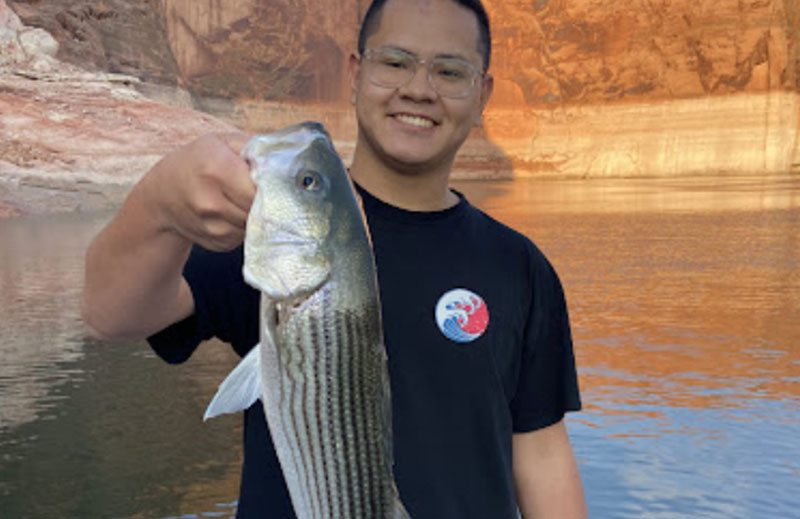
Most people picture Lake Powell as a summer hotspot filled with houseboats, wakeboards, and jet skis. And while summer is certainly the busiest season, it’s far from the only time to enjoy the lake. Winter and early spring transform Lake Powell into a serene, crowd-free escape—ideal for fishing, hiking, photography, and peaceful exploration.
If you’re planning an off-season trip, you might be wondering: What changes in winter and spring? What’s still open? What should I expect? This guide answers all your questions and shows why the cooler months might just be the best-kept secret of Lake Powell.
What Changes in Winter and Early Spring
Weather & Temperature
- Winter Days: Cool, typically in the 40s–50s °F. Nights can dip below freezing, so warm layers are a must.
- Early Spring: By March and April, daytime temps climb into the 60s and 70s—perfect for hiking, fishing, and exploring without summer’s scorching heat.
Water Levels & Conditions
Fewer visitors mean calmer waters. Without the constant churn of houseboats and speedboats, Lake Powell’s surface often looks like glass, creating:
- Ideal conditions for paddleboarding and kayaking.
- Reflection photography opportunities are rarely possible in peak season.
Services & Access
Some services adjust for the off-season:
- Marinas: Wahweap and Antelope Point typically remain open but with shorter hours.
- Boat Rentals & Fuel: Limited in winter—always call ahead.
- Road Access: Snowstorms can temporarily impact routes to boat ramps.
Wildlife Activity
Winter and spring bring unique opportunities for wildlife lovers:
- Migrating birds, including waterfowl and raptors.
- Easier spotting of deer, bighorn sheep, and coyotes along the quieter shorelines.
- Softer, low-angled light for photographing both landscapes and wildlife.
📖 For seasonal updates on Glen Canyon and Lake Powell conditions, check the National Park Service Glen Canyon Recreation Area.
What’s Still Open
Lake Powell doesn’t shut down in the off-season—many experiences remain available year-round.
- Marinas: Wahweap and Antelope Point usually stay open, offering fuel, slip rentals, and limited supplies.
- Fishing: Cooler waters are prime for striped bass, walleye, and crappie—many anglers prefer winter for this reason.
- Hiking & Slot Canyons: Trails and canyons like Antelope Canyon remain accessible all year, and the cooler air makes them far more comfortable to explore.
- Camping: Primitive camping is available year-round. Developed campgrounds often remain open but with reduced services.
What to Expect if You Visit
Bring Layers
Mornings and evenings can be cold, but afternoons often warm up nicely. Pack clothing you can easily layer.
Plan Ahead
Because some marinas and services reduce hours, always double-check fuel availability, boat rentals, and dining options.
Enjoy the Solitude
This is the time for peaceful trips—quiet canyons, empty trails, and wide-open views. Without the summer bustle, you’ll feel like you have the lake all to yourself.
Why Visit in Winter or Early Spring?
Here’s why off-season might be the best season at Lake Powell:
- Fewer Crowds = More Serenity
Imagine paddling through Antelope Canyon without another soul in sight or photographing Lone Rock at sunrise with no boats in the frame. - Cooler Temps for Outdoor Adventures
Hiking, fishing, and exploring are far more comfortable in 60–70°F weather compared to triple-digit summer heat. - Unique Photography Opportunities
Winter skies bring dramatic clouds, softer light, and stunning reflections on calm water. - Fishing at Its Finest
Fish are more active in cooler water, giving anglers some of the best chances of the year to catch striped bass and walleye.
📖 See seasonal fishing forecasts from the Utah Division of Wildlife Resources.
Activities to Try in Winter & Spring
- Fishing Trips: Great action with fewer boats competing for spots.
- Photography Tours: Crisp air and soft light create extraordinary photo opportunities.
- Kayaking & Paddleboarding: Calm waters in off-season months are perfect for paddling.
- Camping Under the Stars: Cold nights bring clear skies, ideal for stargazing and astrophotography.
Looking for a custom trip? Lake Powell Guide Services offers guided fishing, photography, and canyon adventures year-round.
Planning Your Off-Season Trip
- Best Time: December–March for solitude, March–April for milder temps.
- Trip Length: Plan at least 2–4 days to explore different canyons and enjoy relaxed activities.
- Gear Checklist: Layers, cold-weather camping gear, extra food and fuel, and camera equipment.
- Travel Logistics: Nearby airports include Page, AZ, and Flagstaff, AZ. Winter driving conditions may apply, so plan accordingly.
Experience Lake Powell Like Never Before
Visiting Lake Powell in winter or early spring is about more than just skipping the crowds—it’s about experiencing the lake in a way most visitors never do: quiet, calm, and breathtakingly beautiful. With a little preparation, you’ll discover a side of Lake Powell that feels entirely new.
The off-season is the hidden season—and it just might become your favorite.
